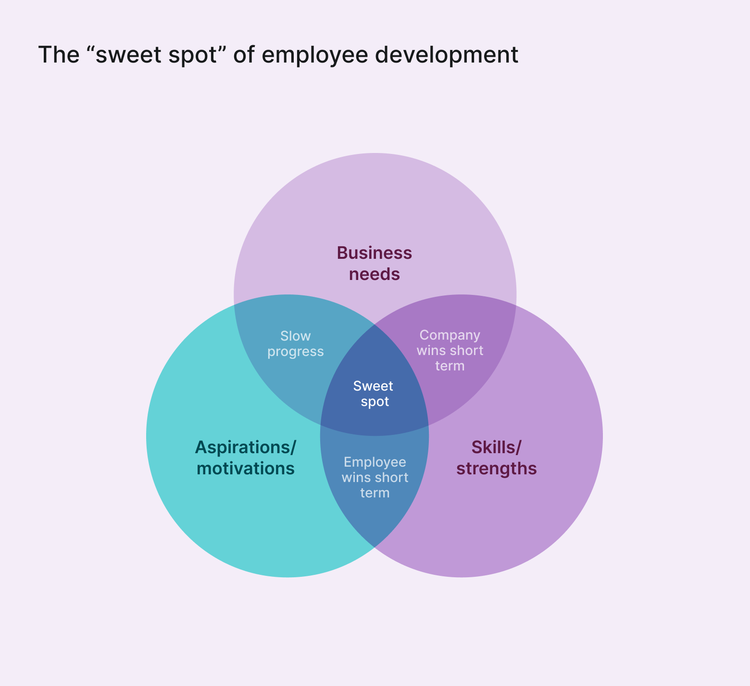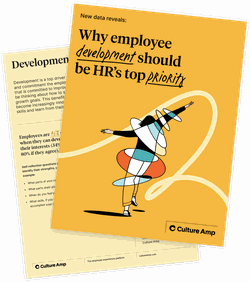
The importance of employee development in the modern workplace

Written by

The employee experience platform
In today’s workplace, career development is changing. Static career paths aren’t as relevant as they were in the past, especially as employees job hop more than ever before. With the Great Resignation underway, many underappreciated employees are shopping around for new roles with better growth opportunities.
To remain a competitive employer, it’s important to keep up with these changes and recognize that it takes more than ever to keep employees around. There’s one obvious answer that few organizations fully utilize: employee development.
Even if you think your business already handles employee development well, it’s worth reconsidering your approach. LinkedIn’s 2022 Global Talent Trends report found that 59% of employees listed professional development as the top area their business should invest in to improve company culture. The importance of employee development to employees is clear – but are company leaders giving it the same attention? Within most organizations, there’s ample room to improve career development, allowing your company to make a meaningful difference in your employees’ lives.
In this article, which is based on our latest eBook, Why employee development should be HR's top priority, we explain what employee development is and why it’s important for every business to prioritize it.
What is employee development?
Employee development is the practice of learning new skills and honing existing ones. With help from their employer, employees can take time to learn how to use new technologies and techniques, develop their knowledge of an industry or subject matter, and grow their competencies across different areas. Employee development is important because employers want highly skilled employees, and employees want to succeed in their roles.
Done right, this ongoing education is mutually beneficial for both employer and employee. For example, it might not make sense for a business to pay for a marketer to learn accounting skills if the organization doesn’t presently need these skills on its team, but, if that marketer takes a class on digital marketing and is able to grow your online presence and secure new business for your company, that will be advantageous for both parties. Your employees can immediately flex their new skills and see the value of their work firsthand, while your business can reap the rewards of their efforts and fill skill gaps.
A great way to find this overlap is to create a career development plan that identifies the skills an individual in this role needs today, as well as the competencies they’ll need to move to the next level in their career path. Investing in skills that will help your employees and your business thrive in the future is a smart move.
There are many different ways to approach employee development. Popular options include ongoing training programs, on-the-job training, mentorships, stretch assignments, conferences, and classes – just to name a few. At Culture Amp, we think of career development in terms of the "3 E's":
- Experience: On-the-job experiences that help employees grow (e.g., stretch tasks, special products, mentoring others, etc.)
- Exposure: Learning through observation (e.g., working with a coach, seeking feedback, shadowing, networking, etc.)
- Education: Structured learning (e.g., courses, books, conferences)
An employee development strategy that incorporates all three provides a holistic path to growth, resulting in well-rounded, successful employees. Moreover, these development goals should be aligned with the larger company goals.

Goals that lie at this "sweet spot" of development motivate employees, help employees understand the company's aspirations, and meet business needs – thus setting up the organization to succeed in the modern workplace.
Why is employee development important?
As mentioned earlier, investing in employee development benefits both your employees and business, but that only scratches the surface of why your organization should prioritize career development. Here are four more reasons to revisit your company’s employee development strategy:
1. Attracting top talent
Employees want to know they can grow within your organization. In fact, Gallup found that 59% of millennials say they find development opportunities extremely important when deciding whether to apply for a position.
To send a strong signal to potential job candidates – one that can help your business stand out during the application and interview processes – highlight any ongoing career development opportunities your organization offers. You want them to know your business will help them learn the skills they will need to qualify for their dream role in the future. Painting a motivating future for potential applicants shows you care about the longevity of their career and want them to grow with your company.
2. Retaining employees
Professional development doesn’t just help your business attract top talent, it also helps you retain top talent. That’s especially important given the current context of the job market. The Great Resignation is still in full swing, and it’s an applicant’s market, so cracking the code to retention can save your business money.
One helpful hint: Culture Amp data from our Why employee development should be HR's top priority report reveals that development is the most cited reason for employee departures – by a longshot. In fact, a lack of opportunities for growth accounts for 37.1% of employee departures. That probably doesn’t come as much of a surprise. If employees think they’re in a dead-end job or aren’t learning, they can quickly become demotivated and look for a new challenge or opportunity outside of your organization. Our data also shows that employees who don’t feel they have access to L&D are 2X more likely to leave a job in the next 12 months.
If you’re wondering how to focus on learning development to increase retention, try experimenting with an e-learning solution, internal mentorship program, or passion project. Encourage your employees to make time during the workday to learn new skills and invest in their growth.
3. Engaging employees
Employee engagement is a valuable metric for every business. Engaged employees are enthusiastic about their work and feel connected to your organization. Engagement and professional development go hand in hand because when employees feel their work is challenging them and pushing them to grow, they are more likely to be engaged, motivated, and even productive and creative than employees who feel stuck. Obviously, this can fuel better business outcomes for your organization, making career development a worthy investment.
4. Improving business performance
Employee development can also strengthen business outcomes. Why? Because professional development keeps employees up to date on industry trends and new techniques, processes, and technology that can help your company increase efficiency and drive innovation. This creates opportunities for your company to introduce cutting-edge strategies and offerings, stay ahead of the market, and deliver better experiences to your customers.
The true importance of employee development lies in employee and business growth. Your talent is your business's most important asset, and any investment in their growth can improve loyalty and retention while increasing workplace productivity and creativity. These factors add up quickly and help you build a future-proof organization made up of driven, talented individuals.
But, don’t take our word for it – trust the data. Our newest report, Why employee development should be HR’s top priority, shares the latest Culture Amp data on why development is a key driver of engagement, retention, and business performance. The guide also offers actionable ways to invest in employee development, best practices from our team of people scientists, and tips on how to get started within your organization.




